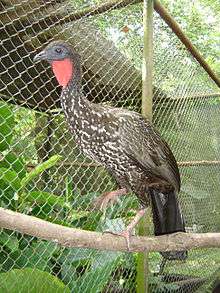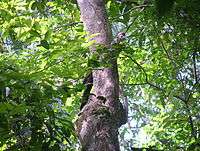Crested guan
| Crested guan | |
|---|---|
 | |
| Scientific classification | |
| Kingdom: | Animalia |
| Phylum: | Chordata |
| Class: | Aves |
| Order: | Galliformes |
| Family: | Cracidae |
| Genus: | Penelope |
| Species: | P. purpurascens |
| Binomial name | |
| Penelope purpurascens Wagler, 1830 | |
| Subspecies | |
The crested guan (Penelope purpurascens) is a member of an ancient group of birds of the Cracidae family, which are related to the Australasian mound builders. It is found in the Neotropics, in lowlands forests ranging from south Mexico and the Yucatán Peninsula to western Ecuador and southern Venezuela. The sexes are similar in appearance; the plumage is mainly dark brown with white spotting, an area of bare skin round the eye, bright red wattles, a bushy crest, a long broad tail and pink legs. It is a social bird, often seen in pairs or small family groups. It feeds in trees, mainly on fruit, and builds a nest of twigs on a branch. The two or three white eggs are incubated by the female. The International Union for Conservation of Nature has rated this bird's conservation status as "least concern".
Description
This is a large gamebird, with a length varying from 84 to 91.5 cm (33.1 to 36.0 in). These birds commonly weigh around 1,750 g (3.9 lb), though can weigh as little as 1,361 g (3.0 lb) in P. p. brunnescens, the smallest race on average. Among standard measurements, the wing chord is 33 to 42.8 cm (13.0 to 16.9 in), the tail is 34 to 41.5 cm (13.4 to 16.3 in) and the tarsus is 7.4 to 9.1 cm (2.9 to 3.6 in).[2][3] It is similar in general appearance to a turkey, with a small head, long strong red legs, and a long broad tail. It is mainly dark brown, with white spotting on the neck and breast. The rump and belly are rufous. The head sports a bushy crest, from which the species gets its name, blue-grey bare skin around the eye, and a bare red dewlap or wattle. The sexes are similar, but young birds have black vermiculations and ochre specks on the body plumage.
The crested guan is a noisy bird with a loud plee or quonk call, a whistled contact call and a powerful keLEEEErrrr! dawn song.
Distribution
The crested guan breeds in lowlands from south Mexico and the Yucatán Peninsula to western Ecuador and southern Venezuela at up to 1,850 m (6,070 ft) altitude.
Ecology

The crested guan is an arboreal forest species. The substantial twig nest is built in a tree or stump and lined with leaves. The female lays two or three large rough-shelled white eggs and incubates them alone.
This is a social bird, often seen in pairs or family groups of 6–12. It walks along branches seeking the fruit and foliage on which it feeds, or flies off with a heavy ani-like flap and glide.
The range of this species has severely contracted outside remote or protected forests due to deforestation and hunting, but it has a very wide range and is a relatively common species so the International Union for Conservation of Nature has rated its conservation status as being of "least concern".[1]
References
- 1 2 BirdLife International (2012). "Penelope purpurascens". IUCN Red List of Threatened Species. Version 2013.2. International Union for Conservation of Nature. Retrieved 26 January 2016.
- ↑ Birds of Peru: Revised and Updated Edition - Thomas S. Schulenberg, Douglas F. Stotz, Daniel F. Lane, John P. O'Neill, Theodore A. Parker III - Google Books. Books.google.com. 2010-05-24. Retrieved 2012-08-30.
- ↑ Curassows, Guans and Chachalacas by Nigel Hughes. Wildside Books (UK). 2006, ISBN 0905062264
- Hilty, Birds of Venezuela, ISBN 0-7136-6418-5
- Stiles and Skutch, A guide to the birds of Costa Rica ISBN 0-8014-9600-4
External links
| Wikimedia Commons has media related to Crested Guan. |
| Wikispecies has information related to: Penelope purpurascens |
- "Crested Guan media". Internet Bird Collection.
- Stamps (for Mexico) shows Range Map at bird-stamps.org
- Crested Guan photo gallery at VIREO (Drexel University)
- Crested Guan species account at NeotropicalBirds (Cornell University)
